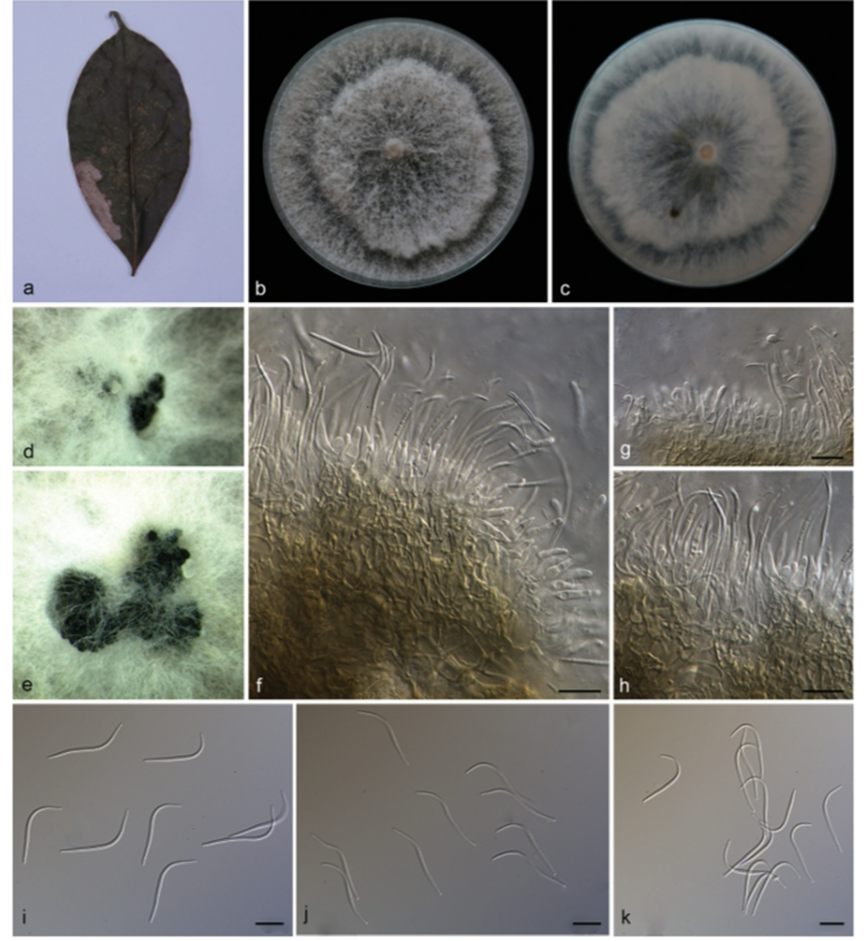 152
152
Diaporthe machili S.T. Huang, J.W. Xia, W.X. Sun, & X.G. Zhang, sp. nov.2021
MycoBank: 837814
Type:China, Yunnan Province: Xishuangbanna Tropical Botanical Garden, Chinese Academy of Sciences, on diseased leaves of Machilus pingii (Lauraceae). 19 April 2019, S.T. Huang, HSAUP194.111 holotype, ex-holotype living culture SAUCC194.111.
Description:
Asexual morph: Conidiomata pycnidial, aggregated, black, erumpent, subglobose to globose, exuding creamy conidial droplets from central ostioles after 30days in light at 25 °C. Conidiophores 7.0–11.4 × 1.8–2.8 μm, hyaline, unbranched, densely aggregated, mostly ampulliform, cylindrical, guttulate, septate, straight or slightly curved, swelling at base, tapering towards apex. Beta conidia 29.0–39.0 × 1.3 1.5 μm (mean = 32.5 × 1.4 μm, n = 20), filiform, hyaline, aseptate, mostly curved, J-shaped, swelling in middle, tapering towards both ends. Alpha and gamma conidia not observed.
Sexual morph: Undetermined
Culture characteristics:Cultures incubated on PDA at 25 °C in darkness, growth rate 16.3–17.5 mm diam/day, aerial mycelium abundant, white on surface, reverse white to pale yellow, with an obvious concentric zonation, pycnidia forming after 15 days.
Habitat: Undetermined:
Distribution:China
GenBank Accession: ITS MT822639,TUB MT855836,TEF MT855951,CAL MT855718,HIS MT855606;
Notes:In the phylogenetic tree, Diaporthe machili forms an independent clade and is phylogenetically distinct from D. caryae and D. sackstonii . Diaporthe machili can be distinguished from D. caryae in ITS, TUB, TEF, CAL and HIS loci by 67 nucleotide differences in concatenated alignment (5/459 in ITS, 10/416 in TUB, 15/334 in TEF, 7/454 in CAL and 30/455 in HIS), and from D. sackstonii in ITS, TUB and TEF loci by 58 nucleotide differences (12/559 in ITS, 23/486 in TUB and 23/348 in TEF). Moreover, Diaporthe machili differs from D. caryae in having longer beta conidia (29.0–39.0 × 1.3–1.5 vs. 15.5–34.0 × 1.1–1.4 μm). Diaporthe machili only produces beta conidia, while D. caryae produces alpha conidia and beta conidia, and D. sackstonii only produces alpha conidia (Thompson et al. 2015; Yang et al. 2018b)
Referenc: [1] Huang, S. , Xia, J. , Zhang, X. , & Sun, W. X. . (2021). Morphological and phylogenetic analyses reveal three new species of diaporthe from yunnan, china. MycoKeys, 78, 49-77.

a infected leaf of Machilus pingii b, c surface and reverse of colony after 15 days on PDA d, e conidiomata f–h conidiophores and conidiogenous cells i–k beta conidia. Scale bars: 10 μm (f–k).

